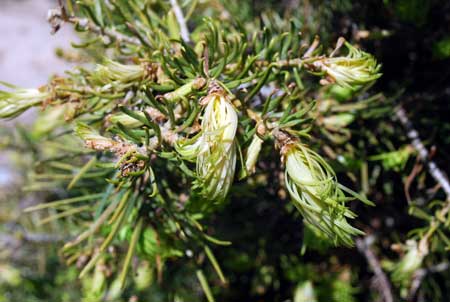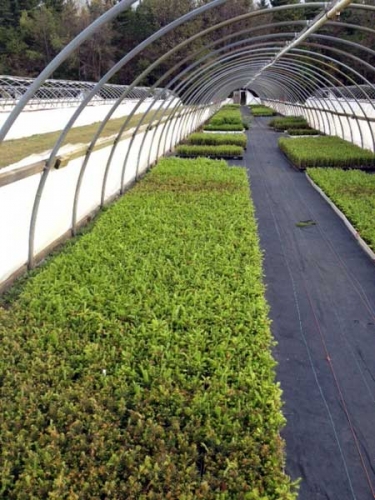By: Bert Cregg, Tom dudek, and Jill O'Donnell
Photo 2. Frost damage to conifer seedlings due to
inadequate sprinkler coverage. Photo credit: Tom Dudek, MSUE
Our situation changed dramatically, however,
during the last weekend in April. Following that freeze we have seen widespread
damage to “the usual suspects” – trees or shrubs that typically break bud early
and therefore are susceptible to frost damage. For conifers this includes black
hills spruce, Douglas-fir, concolor fir, and balsam fir. Among deciduous trees
and shrubs we have seen damage on sycamore, Planetrees, lilacs and honeylocust.
 |
| Photo 1. Freeze damage on concolor. Photo credit: Jill O’Donnell,MSUE |
For growers, this damage impacts production
due to growth losses and loss of quality since damage to newly emerging shoots
can affect tree form. Some nursery growers were successfully able to reduce
frost injury to their crops by irrigating or covering with frost blanket fabric
during freeze advisories. With frequent advisories throughout April, nurseries
applied frost protection up to eight times. One seedling nursery producer
learned the value of frost protection from damage that occurred on the edges of
his irrigation spray patterns, which were not adequately protected (see Photo 2).
Photo 2. Frost damage to conifer seedlings due to
inadequate sprinkler coverage. Photo credit: Tom Dudek, MSUE
Another concern for growers is the ability of
trees and shrubs to recover from repeated frost events. In most cases, trees
will continue to push new growth, but the overall loss of growth is cumulative
and the need for corrective pruning to maintain good form will increase.
Likewise, for homeowners it is important not
to panic when they see extensive frost damage to landscape plants. Late frost
damage can often be dramatic, with entire trees or shrubs covered with brown or
black shoots. It’s important to remember that vigorous plants have ample energy
reserves and will quickly push new growth. For deciduous plants that are prone
to late frost damage, we often see plants suffer extensive shoot die-back, but
then appear essentially normal by mid-summer.
A disconcerting aspect of our outbreak of
frost damage are reports from Detroit suburbs that unscrupulous tree service or
landscape companies are exploiting the situation by trying to convince
homeowners that frost-damaged trees are diseased or require treatment.
Homeowners with frost damaged trees need to keep two things in mind. First,
late frost damage may be unsightly, but is rarely life-threatening for trees
and shrubs. Second, it’s always a good idea to be wary of “doorknockers” that
arrive, uninvited, claiming to diagnose tree problems. Professional, reputable
tree care companies rarely, if ever, go door-to-door soliciting business.
Homeowners looking for help with the trees and other landscape plants should
check the yellow pages or the web for companies that are affiliated with
professional associations such as theInternational
Society of Arboriculture, Arboriculture
Society of Michigan, Michigan
Green Industry Association or theMichigan
Nursery and Landscape Association.
This article was published by MSU Extension.
For more information, visit http://www.msue.msu.edu.
To contact an expert in your area, visit http://expert.msue.msu.edu, or call
888-MSUE4MI (888-678-3464).













No comments:
Post a Comment